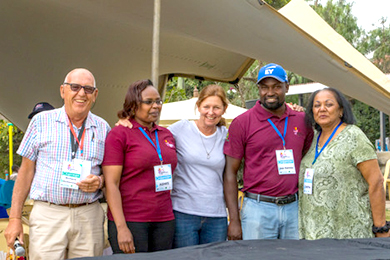
NHFair 20th year debut, Growing bigger & better
Naivasha Horticultural Fair is on its 20th year debut. The organizers say that this premium gathering of flower breeders, growers, and input suppliers has boosted the place of the Kenyan flower sector across the globe.
“We are ranked as one of the top horticultural shows in the world. The Naivasha Horticultural Fair has created a big impact on the flower industry in the last twenty years. The flower growers are no longer attracting negative news as they used to,” said Richard McGonnell, the Chairman of the fair.
A part from giving back to society from the proceeds from the fair by supporting local charities, health facilities classrooms, and a safe house, the chairman adds that the economic gains to the town are enormous.
“The economic gains that the fair brings to Naivasha town are in the tens of millions for the hotel sector. The fair has also created a lot of awareness among Kenyans on the latest technologies in the horticultural sector. It has had a huge impact in and around Nakuru County,” Mr McGonnell told Hortfresh Journal during an interview.
“We have just finished building a secondary school in Nyamathi close to 13-14 classrooms over the last 7-8 years. This year we will certainly help another school”. The Fair also runs a safe house that houses more than 30 children.
The organizers say that they are putting more effort into uplifting small-scale flower growers to boost volumes. Last year, apart from the big stands, they had small stands just for small-scale growers. “Last year, for example, Elgon Kenya had a stand for small growers and it was the busiest stand at the fair.”
“We are developing slowly to help the smallholder farmers. It’s difficult to pinpoint what’s going to be new or not in this year’s fair. In other fairs, it’s a businessman’s fair, but at the Fair, we are looking on the professional side of horticulture, and interrogating the latest trends and technologies,” noted McGonnell.
Kenya’s horticultural sector is a citadel of the country’s economy with exports accounting for a significant portion of the revenue. Millions of people depend on these exports for their livelihoods.
In 2022, the horticultural industry contributed about $1.1 billion to exports. And nearly 52 percent of the exports by weight and 70 percent by value. Kenya remains the biggest source of flowers with growers diversifying.

Kenya’s horticulture sector earned the country Shs154 billion in 2021, with flowers alone bringing in Shs110 billion.
However, the major challenge facing the flower sector, added McGonnell, is the high cess tax and increased water tariffs “noting that they are the ones imposed by the government and county councils.”
He said these punitive taxes are “threatening to bring down the multi-billion flower sector”. McGonnell notes that the business environment has forced some flower farmers to close shop, scale down, or change their nature of business.
This, he says, is an unfair taxation to the whole of the Kenyan flower industry considering the hundreds of thousands of jobs that the sector has created.
“The newly set cess rates for growers in Meru County, for example, could see farms closing down. In the County, for example, they have put a cess tax of sh 0.20 per every kilogram of flowers. The Water Resource Authority (Warma) is also charging growers tax @ Ksh 5.00 per M3 from the use of water in their farms,” added McGonnell.
Historically, air freight has dominated the horticultural transport scene. But the rallying calls to reduce greenhouse gas emission and the rising costs of air freight has pushed flower-growing countries to transition to sea freight for horticultural exports.
Columbia, Kenya’s competitor in the flower industry, already ships 15 percent of its exports by sea. In 2022 the industry announced an ambitious move to ship 50 percent of all flower exports by sea.
According to McGonnell sea freight presents a mixed bag of reactions. He explains that sea freight is not well organized in Kenya.
“Sea freight works and doesn’t for others. It all boils down to management issues on the farm. Unfortunately, sea freight from South America takes 14 days, but sea freight in Kenya which is just next to Europe takes 35 days, meaning it’s not well organised,” he explained.
“Taxes on landing fees and freight charges in Kenya are far too high. The government should bend and make the flight landing in Kenya as cheap as possible, also for the tourist industry ! The government is making too much money from the industry and it has a detrimental effect on the flower farms.”
Considering what is happening to our neighbors in Ethiopia, the Flower/Hort/Agri Industry has huge potential, and huge employment, with one new farm near Naivasha starting with 1,000 employees. This year’s Horti Fair is sponsored by Elgon Kenya, Osho, Greenlife Crop Protection, Agrichem & Tools East Africa, and Amiran among others. Each sponsor will get a stand in a prominent position to showcase their products.

